NICT has researched and developed Cognitive Wireless Clouds technology that selects radio access network according to the radio use conditions around the user. The goal is to contribute to improvements in communications capacity and quality, effectively and efficiently utilizing radio resources in today’s tight radio use conditions. The developed Mobile Wireless Router was achieved by merging and developing the established IEEE 1900.4 specifications and NICT’s Cognitive Wireless Clouds technology.
Home > Press Release > MOBILE WIRELESS ROUTER CONFORMING TO WORLD’S FIRST COGNITIVE WIRELESS STANDARD (IEEE 1900.4)
- Provides Appropriate Mobile Connection Environment to Terminal According to Surrounding Radio Use Conditions -
The National Institute of Information and Communications Technology (NICT; Hideo MIYAHARA, President) developed a mobile wireless router (Mobile Wireless Router) conforming to IEEE 1900.4 specifications. The Mobile Wireless Router automatically selects the optimum connection from among multiple available connectable radio access systems, based on radio use conditions and network manager support information then connects to the Internet. It also operates as a wireless LAN access point for terminals and providing an Internet connection environment.
The Mobile Wireless Router supports IEEE 1900.4 specifications, supports multiple wireless systems for connecting to the Internet, while performing as an access point for terminals and relaying between local area wireless networks holding multiple terminals and the Internet through NAT. The connection switches automatically to the optimal wireless system because the wireless system the user wants to use primarily and its authentication information are preset to the Mobile Wireless Router. The Mobile Wireless Router possesses functions for exchanging between the network wireless resource manager and messages set on the network, using analyzed communications quality information and determining the appropriate external network according to radio use conditions.
We will explore effective use methods for the Mobile Wireless Router in services provided by radio access businesses [including Mobile Virtual Network Operator (MVNO)]. There is also promise for use as a method for radio resource management and effective use in new generation network architecture.
NB:
The Mobile Wireless Router was developed under a contract of R&D for radio resource enhancement, organized by the Ministry of Internal Affairs and Communications, Japan.
IEEE 1900.4 Specifications
IEEE 1900.4 specifications focus on improving the retention capacity and service quality of the entire wireless system in environments where multiple radio access technologies exist, and is being discussed in the IEEE SCC41 P1900.4 Working Group.
The IEEE (Institute of Electrical and Electronic Engineers) is an association of electrical and electronics fields in the United States. It holds international conferences, issues papers and establishes technical standards in the stated fields. SCC41 (Standards Coordinating Committee 41) is a standardization committee created under the IEEE to establish standard specifications for elemental technology required in order to achieve a dynamic spectrum access network. Further, it was originally referred to as P1900; however, it was reorganized as SCC41 and continues on to today. In the SCC41, there is the P1900.4 Working Group discussed earlier, as well as P1900.1 that establishes terminology definitions, P1900.2 that establishes definitions for the coexistence methods for radio and interference waves and P1900.6 that establishes wireless sensing interfaces, and otherworking groups
NAT (Network Address Translation)
This is a function for exchanging internal IP addresses with external IP addresses when communicating externally using system IP addresses that differ between external and internal networks. The NAT function enables more devices to be connected to the Internet under IP address assignments, and has recently been embedded to residential and commercial Internet connection devices.
Technical Contact
Hiroshi HARADA, Group Leader /
Kentaro ISHIZU, Expert Researcher
Ubiquitous Mobile Communications Group
New Generation Wireless Communications
Research Center
Tel:+81-46-847-5098
Fax: +81-46-847-5110
E-mail: 
















E-mail: 
















Press Release Contact
Sachiko HIROTA, Specialist
Plublic Relations Office
Strategic Planning Department
Tel:+81-42-327-6923
Fax:+81-42-327-7587
E-mail: 



















Attachment
There is demand for effective and efficient use of radio resources to enable high speed, high capacity and high quality wireless communications in today’s tight radio use conditions. Research and development of cognitive wireless technology has advanced globally towards commercialization in order to achieve this. In addition, methods for management and effective utilization of radio resources are continuing to be examined in new generation network architecture where NICT is advancing research and development. As such, specifications have been established for IEEE 1900.4 standards incorporated by NICT in February 2009.
NICT developed the world’s first Mobile Wireless Router merging established IEEE 1900.4 specifications with Cognitive Wireless Clouds technology currently being researched and developed, and conforming to IEEE 1900.4 specifications. Cognitive Wireless Clouds technology is being researched and developed by NICT in order to select a radio access network according to the radio use conditions around the user.
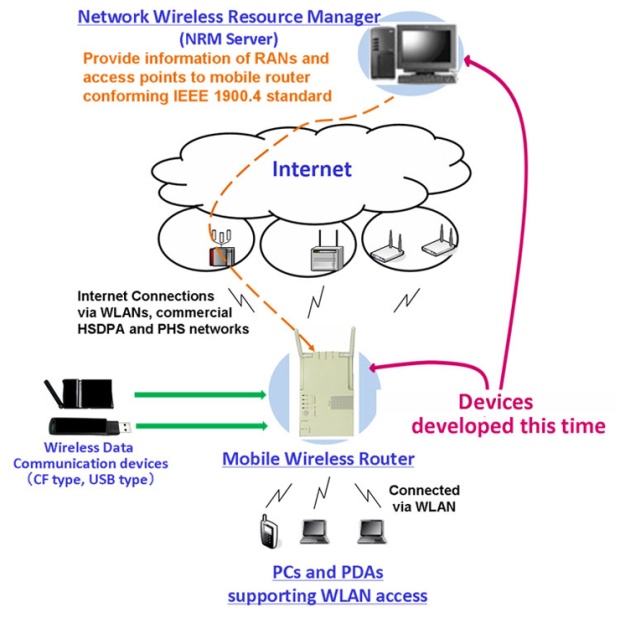
Mobile Wireless Routers possess multiple connection methods to the Internet (wireless LAN, PHS, etc.) while operating as a wireless LAN access point to area terminals. Connections to the Internet are relayed to terminals using NAT. Therefore, terminals can connect to the Internet using wireless LAN regardless of the connection method the Mobile Wireless Router is connected to.
Presetting the Internet connection method and authentication information the user prefers to the Mobile Wireless Router allows for automatic switching to the optimal radio access network according to the radio use conditions of the surrounding area. This is because the Mobile Wireless Router is continuously measuring the radio strength of the access points (and base stations) and selecting the optimal connection method according to the radio environment as per these settings. Further, the Mobile Wireless Router exchanges signaling messages conforming to IEEE 1900.4 specifications between the network wireless resource manager (hereafter, Manager) installed on the network. The Manager collects measured values obtained by the terminal on wireless system communications speeds and delays, samples characteristics on wireless networks and access points from this information, and feeds it back to the terminal as criteria for the terminal to select a wireless network. A more appropriate connection is made from the terminal to the wireless network with the Manager as feedback information cannot be understood through the terminal taking measurements alone, resulting in effective use of all wireless resources. Thus the wireless network and its timing where the new connection should be made are determined by the terminal based on its measured information and the information gained by the Manager. The Manager is also physically independent from a wireless network device, so an individual or organization provided with the Manager can freely install it on the Internet because there is no need for direct communications between them.
The Mobile Wireless Router can also be used while moving around because the connection environment is automatically selected according to changes in the radio environment. The user can walk around with the wireless LAN Internet connection environment as is with the Mobile Wireless Router in their bag, etc. Although a connection to the Internet could not be established traditionally outside the wireless LAN service area with a communications terminal that only possesses a wireless LAN connection method, the Mobile Wireless Router enables an Internet connection via a wireless LAN anytime and anywhere. Depending on the connection method selected, the Mobile Wireless Router operates continuously for more than 3 hours using a built-in battery.
The Mobile Wireless Router has a built-in wireless LAN as the communications device for Internet connection, it can also use commercially available USB and CF card type communications devices (HSDPA: High Speed Down Link Packet Access; PHS: Personal Handyphone System, etc.) as options. Wireless LAN supports hot spot connections, and the operation of optional devices such as EMOBILE’s D12LC and WILLCOM’s AX420N is currently being verified. Supported communications devices rely on the installed driver types, but it will also be compatible with new communications devices through driver expansion.
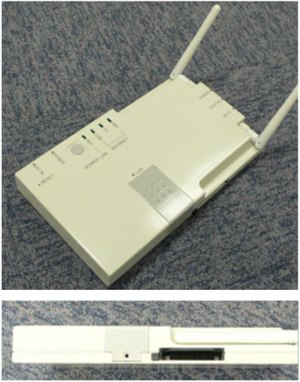
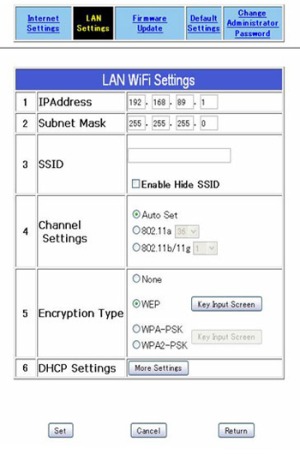
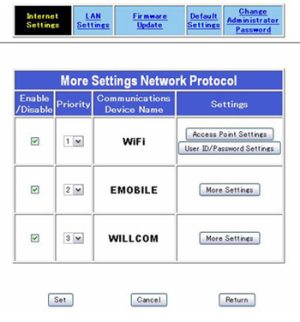
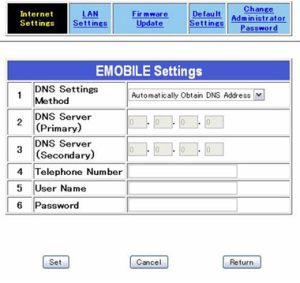
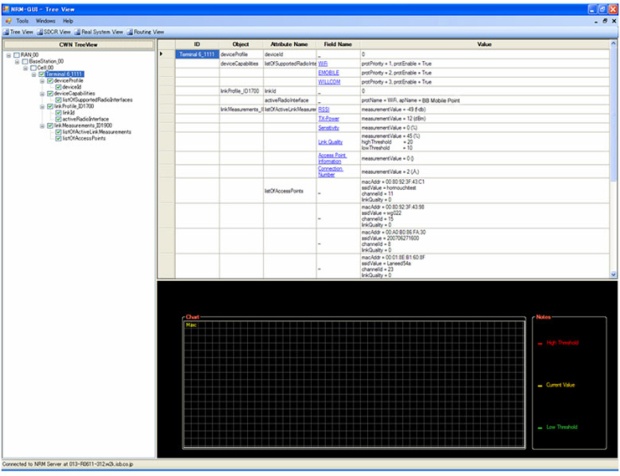
Network Wireless Resource Manager control screen. Statistical quality information and the number of connections, etc. for specific wireless LAN access points can be displayed. Additional information can also be provided to the terminal by setting attributes to specific access points
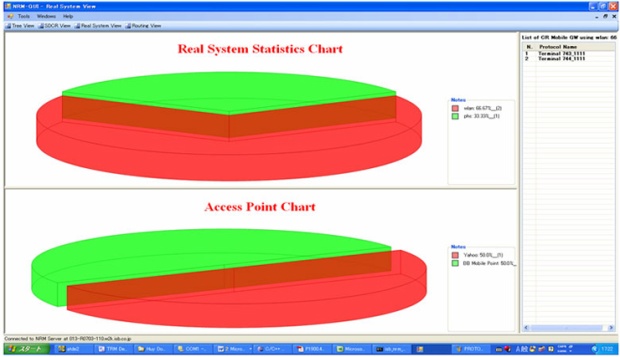
Terminal connections can be classified and displayed for specific terminal groups from a variety of perspectives such as wireless system type (wireless LAN, PHS) or business entity. As a result, a bias towards a wireless system use method in specific areas can be discovered, and wireless systems that may conform to application properties may be recommended to terminals. Thus the user can be satisfied greater because of effective frequency use.
Basic architecture defined in the IEEE P1900.4 specifications is shown in the diagram. They generally consist of three parts; core network, wireless access network and terminal. This specification defines OSM and NRM to core network, RRC and RMC to wireless access network, and TRM, TRC and TMC to terminal, and defines their functions and interfaces.
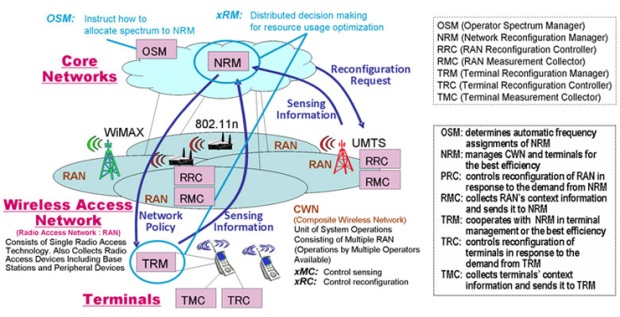
Cognitive Wireless Clouds (CWC) technology has been in development by NICT since 2007 as a wireless network architecture technology for terminals to set and switch between multiple wireless systems with different characteristics autonomously and decentralized according to user preferences. This allows for optimization with network control prioritizing range flexibility, maximizes the use of wireless resources not being used as needed, and improves frequency use efficiency. It also integrates multiple wireless link bands for communicating, allowing for small segmenting and integrated use of standalone wireless bands that are not being used, or provides wide band, stable communications to terminals by operating actively on multiple operators.






